|
|
I’ve noticed while interviewing hundreds of winemakers that as a whole they are rather positive about their wine and life in general. So I decided to see if I could channel some positive thoughts about the weather we have been having in Central Maryland. Last week heat indexes rose beyond 110º F. Can anything be positive about that?
I’ve noticed that with our humidity, a glass of ice tea sweats rather profusely during the summer time. I wondered if a wine bottle filled with water and refrigerated would sweat so much that the label would come off. I reuse wine bottles for bottling the wines I make at home. So I tried three wine bottles. Sure enough, they began to sweat soon after taking them outdoors from the refrigerator. Within twenty minutes two of the labels easily peeled off leaving no glue on the glass. The third bottle’s label proved to be more difficult. It did come off with a razor blade but left behind glue. I used WD-40 to remove the glue. This method to remove wine bottle labels is no great discovery. It is not the best way to remove labels. It was easy though and now I can look forward to a silver lining when heat indexes exceed 110º F.
Cheers,
Terry
Label design was something I’ve dreaded for more than a couple years. I had to make some decisions this past weekend though and get the design for the bottle label completed for the wine we have in barrel at Vint Hill Craft Winery in Virginia. Our label must be approved by the TTB. I don’t fully understand this. The wine is for personal consumption and is not going to be sold. However, it could be sold at Vint Hill Craft Winery. Having to deal with the government does afford a learning experience and is a gentle reminder that wine made all over the world is influenced in the vineyard, by the winemaker and by government.
For my design my goal was to create something simple and traditional. The font Didot was used since this is a traditional French font. We decided to use the word Illuminatus for our labels when we bottled our wine made at Tin Lizzie Wineworks in Maryland. The word is Latin and means enlightenment. Making wine at Tin Lizzie Wineworks and at Vint Hill Craft Winery has certainly been enlightening. So I want to call this wine Illuminatus also. I also want to use the vintage year, 2009, and the varietal name Cabernet Sauvignon on the front label. What I want and what I’ll have to do may be two separate things though. There are all these rules that one has to deal with. My back label has the government warning and the wine was produced and bottled at statement. I’m also trying to have a statement of where the grapes were sourced, when they were sorted and when the wine went into oak and was bottled.
Here are my designs for the front and back labels. It will be interesting to see how many edits I’ll have to make to comply with government rules.
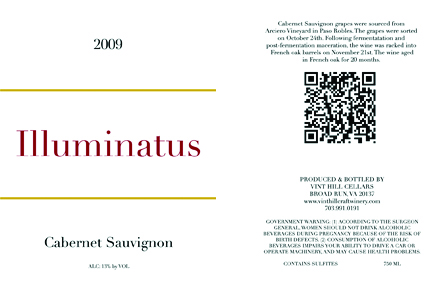
Cheers,
Terry
We have been traveling for the past two weeks. When we left, there were between six and ten inches of growth in the vineyard. On our return we found the Dornfelder vines with about two feet of additional growth, while the Niagara vines put on two to three feet of growth. Out came the pruning sheers.
The Dornfelder is covering one half of a gazebo providing shade from the sun. I came up with the idea of using Dornfelder while visiting Fulkerson Winery in New York’s Finger Lakes wine region. They had Dornfelder climbing up the side of a barn. My thinking was that if the vine can climb all the way up the side of a barn, it could cover and fill in half of the top of a gazebo. Last year I trained the two vines to cover the half of the gazebo I wanted to cover. This year the vines are filling in more of the area providing more shade below.
The Niagara vines are growing along a trellis system. If left unchecked they would grow and grow and grow. The four vines have no problem with a foot of growth a week at this time of year. If the vine hits me in the face it’s going to be pruned.
Both the Dornfelder and Niagara have plenty of berry clusters not quite ready to flower. Last year we did manage to harvest 15 pounds of the Niagara. The birds claimed the Dornfelder. Last year’s concern was black rot that claimed the Niagara the previous year. I have been religiously spraying with a Bordeaux mix and had no black rot issues last year. I’ll continue with the Bordeaux mix this year. We are looking for stink bugs though. They have been in the house all winter long even while vacuuming five to ten a day. I suspect that the garden will be amassed with them this year.
Cheers,
Terry
Walking along the vines and pulling off the suckers is a simple task. The suckers can simply be bent and they will come right off. Their removal encourages sap to rise in the vine. I discovered the act of removing suckers to be quite pleasant. One is out amongst the vines doing a task that permits the mind to wander. At the same time there is a strong life force going on in the vine. Leaves have now burst forth. It was only a few days ago the buds were swelling. Soon the small grape clusters will flower.
One needs to be vigilant in removing suckers. It seems as though another will spring forth within seconds of removing one. Actually it may take a few days and it was more likely that I just didn’t originally see the one that appeared to grow in seconds. So now my vineyard task is to remove the suckers and marvel as the vine produces leaves and berry clusters.
Cheers,
Terry
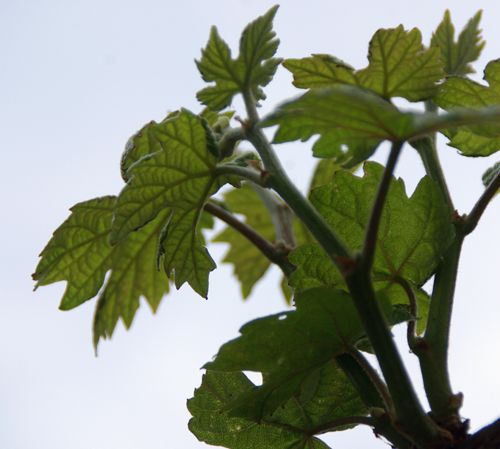 New growth on the Dornfelder vines
We made some wine from the few pounds if Niagara harvested from our property last fall. Only six 375 ml bottles were made. This was really a small lot. However, we tended the vines and grapes, harvested the grapes and made wine. The whole experience was valuable. I fermented the wine to dry however wanted to sweeten it before bottling.
A winemaker suggested that I look into sweetening the wine with Splenda. The argument is that Splenda has non-fermentable form of sweetness. I first began to research winemaking forums for opinions of using Splenda to sweeten wine before bottling. There were two schools of thought. One was that Splenda is non-fermentable and would work perfectly. This was the predominant opinion. The other school of thought is that over time, the Splenda would break down into fermentable sugars. If there were yeasts in the bottle, the wine will begin to ferment.
Well, I opened a bottle to have with a shrimp risotto last evening. As soon as the cork was removed there was fizz in the neck of the bottle. When the wine was poured into wine glasses, it fizzed almost as much as a sparkling wine. However there was no stream of bubbles from the bottom of the glass. My guess was that the wine did re-ferment in the bottle. Most winemakers would say this was a faulty wine.
It tasted wonderful! The aroma and taste were very floral with the typical Niagara characteristics. There was enough effervescence to slightly tickle the tongue. The finish was somewhat cleansing and there was a long aftertaste that became what many refer to as foxy. However when paired with the shrimp risotto, the foxy finish stopped. This made a good pairing. We enjoyed this wine and now the challenge is to make it again. I wonder what would happen if I bottled it in beer bottles and capped it?
Cheers,
Terry
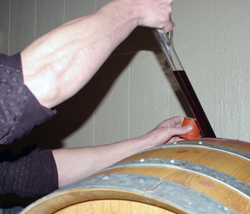 We had an opportunity to stop by Vint Hill Craft Winery yesterday to taste our 2009 Cabernet Sauvignon still in a French oak barrel. The last time we tasted it was last summer. Wow! What a difference eight months can make. The fruity character of the wine was present as it was last summer, a little easier to tell this time though. What were different were the influence of oak and the tannins. We had an opportunity to stop by Vint Hill Craft Winery yesterday to taste our 2009 Cabernet Sauvignon still in a French oak barrel. The last time we tasted it was last summer. Wow! What a difference eight months can make. The fruity character of the wine was present as it was last summer, a little easier to tell this time though. What were different were the influence of oak and the tannins.
Last summer the presence of oak was overwhelming. The oak was in your face. Now the influence of oak on the aroma and taste is moving to the background. It is still there but not aggressively. Last summer the tannins were bold and harsh. Now the tannins are silky.
We made a decision to age in French oak an additional year. This seems to be the correct decision. I spoke to another Vint Hill vintner who made a Cabernet Sauvignon at the same time we did in the fall of 2009. His Cab was bottled last summer. During the Wineries Unlimited Trade Show and Conference he said his wine was still rough and needed more bottle aging. The wine we have in the barrel is not rough and it was nice to experience the differences that additional aging can accomplish.
Cheers,
Terry
If one attends the winemaking sessions at Wineries Unlimited, they’ll quickly realize the presenters know their chemistry. Be prepared for slides with chicken wire-like images of molecules representing tannins, proteins and others. Speaker Clark Smith, who during his sixty-minute presentation made three statements that I didn’t understand any of the words in the sentences, challenged my comfort zone. The rest I could follow. Presenter James A. Kennedy also used chicken wire-like images in his presentation, but did an excellent job explaining it for those in the audience that didn’t have a chemistry degree.
Both speakers emphasized the importance that tannins play in all aspects of red wine. Tannins influence a red wine’s aroma, flavor, taste, mouth feel, and finish. The actual chicken-wire chemistry, although presented, doesn’t detract from the conclusions on what winegrowers and winemakers can do to aid in the development of skin tannins and minimize the effect of seed tannins on the wine.
Cheers
Terry
The theme for the Newcomers sessions at the Wineries Unlimited Trade Show and Conference was to plan well before spending a dime. Many vineyards and wineries err when first starting out because planning could have been better. One of those errors includes purchasing smaller or less expensive equipment than is needed to make premium wines. Presenter John Levenberg advised that if one does not have the upfront capital it would be best to change their goals. John presented the cost to create a 1300 case winery producing premium wines. His calculations came out to around $325,000 not including the building, labor or bottling.
Other speakers discussed alternatives to starting a stand-alone winery. These included custom crush facilities and alternative proprieterships. These sessions could have been a bit more streamlined.
During the evening there was a welcome reception. Many attendees brought a bottle of their wine to share with those attending Wineries Unlimited. We met winemakers and vineyard owners from Michigan, Virginia, Maryland, Ohio, West Virginia and Nova Scotia. True to the Colonial Virginia setting, three visitors included former Virginians.
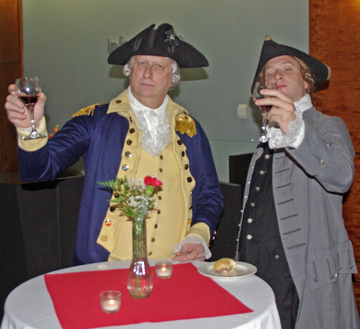
At last year’s Wineries Unlimited I had the chance to spend a day at the Trade Show. I learned a lot about closures such as the Zork (great commercial), barrels, winemaking materials such as those by Laffort and many other things from interesting vendors. This year I’m going to devote two days to the Trade Show. There is so much when chatting with 300 vendors, that information overkill is easy to feel in one day. Hopefully two days will afford some processing time.
In addition to the trade show, Kathy and I are going to several of the viticulture, enology and marketing seminars. One challenge is to attend sessions when more than two we are interested in occur at the same time. That’s an example of a good problem.
Here is a list of topics presented at this year’s Wineries Unlimited:
Viticulture and Enology
-Effects of Vineyard Management Practices on Wine Aroma and Flavor
-Impact of Vineyard Management Practices on Grape and Wine Phenols
-Vins de Terroir vs. Vins d’Effort. Why Terroir Matters
-Comparison of pruning method and severity on vine growth and productivity of Chardonnay grapevines
-Wine Structure Goals and Strategies
-Recent advances in canopy management
-Winemaking Effects on Mouthfeel
-Vineyard floor management options
-Post Modern Winemaking Revolutions
Marketing and Sales
-The Basics: Developing Your Business Plan, Sales Projections, Estimating the Size of your Market, Creating your Unique?Selling Proposition
-Developing the Message
-Targeting Your Audiences: Who are Those Guys? What do They Want?
-How To Sell Wine: The Techniques of Selling Wine and What works with consumers, what restaurants want
-Getting the Word Out How to deliver the message, social Media for small wineries and Why Education Matters
-How do you know if it is working? Using metrics to measure your marketing: sales, visits, calls, clips and friends
Hope to see you at Wineries Unlimited.
Cheers,
Terry
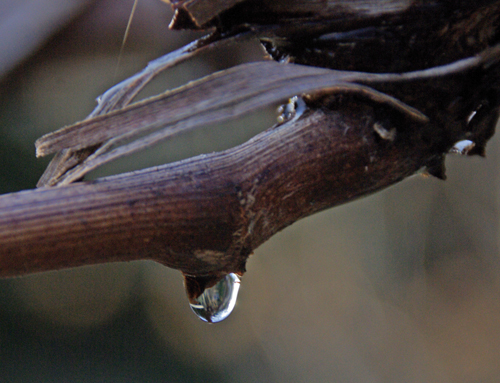 After pruning my home vines, I caught them weeping. The teardrop glistened in the sunshine sparkling like a diamond. The weeping foreshadows the growing season. It is the first step in the vine’s life cycle. It signifies that the ground temperature has risen to around 50º F. The vine’s roots are taking up water and nutrients. The water passes through the vine and exits as sap where the vines were pruned. After the colder than average winter, any signs of spring are welcome. It is important to note that weeping is not synonymous to crying. Weeping is a normal part of the vine’s lifecycle and is not the same as human crying. After pruning my home vines, I caught them weeping. The teardrop glistened in the sunshine sparkling like a diamond. The weeping foreshadows the growing season. It is the first step in the vine’s life cycle. It signifies that the ground temperature has risen to around 50º F. The vine’s roots are taking up water and nutrients. The water passes through the vine and exits as sap where the vines were pruned. After the colder than average winter, any signs of spring are welcome. It is important to note that weeping is not synonymous to crying. Weeping is a normal part of the vine’s lifecycle and is not the same as human crying.
Cheers,
Terry
|
|








Removing Wine Bottle Labels
I’ve noticed while interviewing hundreds of winemakers that as a whole they are rather positive about their wine and life in general. So I decided to see if I could channel some positive thoughts about the weather we have been having in Central Maryland. Last week heat indexes rose beyond 110º F. Can anything be positive about that?
I’ve noticed that with our humidity, a glass of ice tea sweats rather profusely during the summer time. I wondered if a wine bottle filled with water and refrigerated would sweat so much that the label would come off. I reuse wine bottles for bottling the wines I make at home. So I tried three wine bottles. Sure enough, they began to sweat soon after taking them outdoors from the refrigerator. Within twenty minutes two of the labels easily peeled off leaving no glue on the glass. The third bottle’s label proved to be more difficult. It did come off with a razor blade but left behind glue. I used WD-40 to remove the glue. This method to remove wine bottle labels is no great discovery. It is not the best way to remove labels. It was easy though and now I can look forward to a silver lining when heat indexes exceed 110º F.
Cheers,
Terry